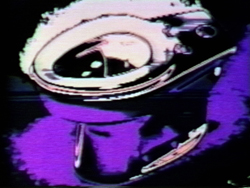Description
Writes Matsumoto, "I used the Erekutoro Karapurosesu (Electro Color Processor), which is mainly used in the field of medicine and engineering, to create moving image textures Metastasis, I was interested in layering images of a simple object and its electronically processed abstraction. The electronic abstract image is manipulated in a certain rhythm, depicting an organic process."
After college, Toshio Matsumoto began working at Shin-Riken Film Company and created Ginrin (1955), a progressive commercial film, in collaboration with the members of Jikken Kōbō or Experimental Workshop, an artist' group consisting of composers and artists. Since then, he has produced numerous experimental documentaries in addition to developing and publishing his own film theories.
In the 1960s he started making experimental films and video art, influencing many other artists. Among his works are For the Damaged Right Eye (1968), Space Projection Ako (1970) for the Textiles Pavilion in Japan Expo '70, and Mona Lisa (1973). He has also directed commercial films, including Funeral Parade of Roses (1969) and Dogura Magura (1988). His book Eizō no hakken: Avangyarudo to dokyumentari (Discovery of Image: Avant-garde Documentary) was published in 1963 and republished in 2005.
